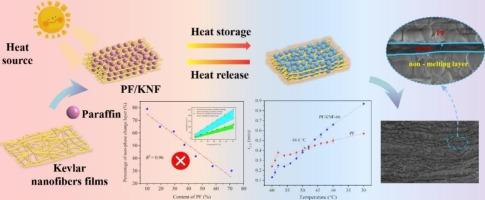Influence of confinement on the thermophysical property of paraffin wax/Kevlar nanofibrous phase change film
IF 8.9
2区 工程技术
Q1 ENERGY & FUELS
引用次数: 0
Abstract
The introduction of porous matrix in shape stable phase change materials (PCMs) alters the phase transition behavior of confined molecules. The mechanism by which the matrix affects the thermophysical properties of composite PCMs is still unclear, even there are conflicting understandings of the same phenomenon. According to this, paraffin/Kevlar nanofibrous films (PF/KNF) with different PF contents were fabricated by one step self-assembly method to comprehensively evaluate the regulation of confinement effects on the thermophysical properties and crystallization kinetics of confined PCMs. Due to the strong self-assembly tendency of Kevlar nanofibers in proton environment, paraffin passively wrapped in the network of matrix, forming a sandwich layered structure. The confinement of matrix altered the crystal structure of paraffin, even leading to the amorphous states in films with lower paraffin content. It also leaded to the formation of a non-melting layer at host-guest interface, thereby reducing the latent heat of composite PCMs. The latent heat of PF/KNF-70, the film with the highest paraffin content without leakage, decreased by about 32.7 % compared to the theoretical enthalpy calculated based on the mass percentage of paraffin in composite. In addition, the percentage of non-phase transition layer decreased linearly with the increase of PF content. The results of crystalline dynamics indicate that the matrix plays a dual role in providing nucleation sites and inhibiting molecular motion. When crystallization occurs at higher temperature (48.8 °C in this study), providing nucleation sites and promoting crystallization dominated the process, while inhibiting molecular motion and reducing crystallization rate become more prominent when crystallization temperature decreases.

约束对石蜡/凯芙拉纳米纤维相变薄膜热物理性质的影响
在形状稳定的相变材料(PCM)中引入多孔基质会改变封闭分子的相变行为。基质影响复合 PCM 热物理性质的机制尚不清楚,甚至对同一现象的理解也存在冲突。有鉴于此,本研究采用一步自组装法制备了不同 PF 含量的石蜡/凯夫拉纳米纤维膜(PF/KNF),以全面评价约束效应对约束 PCM 热物理性质和结晶动力学的调控作用。由于 Kevlar 纳米纤维在质子环境中具有很强的自组装倾向,石蜡被动地包裹在基体网络中,形成了夹层结构。基质的约束改变了石蜡的晶体结构,甚至导致石蜡含量较低的薄膜出现非晶态。它还导致在主客界面形成非熔化层,从而降低了复合 PCM 的潜热。与根据复合材料中石蜡的质量百分比计算出的理论焓值相比,石蜡含量最高且无泄漏的薄膜 PF/KNF-70 的潜热降低了约 32.7%。此外,非相变层的百分比随着石蜡含量的增加呈线性下降。结晶动力学结果表明,基体在提供成核场所和抑制分子运动方面起着双重作用。当结晶发生在较高温度(本研究中为 48.8 °C)时,提供成核位点和促进结晶的作用占主导地位,而当结晶温度降低时,抑制分子运动和降低结晶速率的作用更加突出。
本文章由计算机程序翻译,如有差异,请以英文原文为准。
求助全文
约1分钟内获得全文
求助全文
来源期刊

Journal of energy storage
Energy-Renewable Energy, Sustainability and the Environment
CiteScore
11.80
自引率
24.50%
发文量
2262
审稿时长
69 days
期刊介绍:
Journal of energy storage focusses on all aspects of energy storage, in particular systems integration, electric grid integration, modelling and analysis, novel energy storage technologies, sizing and management strategies, business models for operation of storage systems and energy storage developments worldwide.
文献相关原料
公司名称
产品信息
阿拉丁
Tween 80
阿拉丁
Span 80
阿拉丁
Potassium hydroxide (KOH, AR)
阿拉丁
Dimethyl sulfoxide (DMSO, AR)
阿拉丁
Paraffin wax
 求助内容:
求助内容: 应助结果提醒方式:
应助结果提醒方式:


